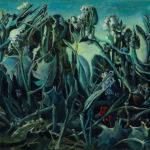

Max Ernst
Painted in 1936. La joie de vivre belongs to a series of paintings Ernst created at the start of civil unrest across Europe and following a premonition he had of the horrors of war to come. Reflecting on the political turbulence and violence with a sense of sarcasm, the present work is one of three known in the series as La joie de vivre (The joy of living).
In La joie de vivre, Ernst renders lush, thick, and tangled foliage with exact detail and precision. These mysterious, even sinister forms belonging to the plant kingdom followed a series of earlier paintings Ernst created in the 1930s of botanical phantasmagoria where surrounding foliage creeps forward, threatening to overwhelm and reclaim the city, and ultimately marking the end of a civilization. In Ernst’s biography, Max Ernst: life and work (1967), the author John Russell observes:
“The subtext in these paintings is Europe's headlong decline in chaos and violence during the 1930s. In the year that Ernst painted this canvas, the political battles between left and right in Spain erupted into civil war. In La joie de vivre, Ernst suggests a metaphor between the tangled forms in nature, and the maze of the human consciousness--both realms are impenetrable, unknowable and fraught with peril.”

